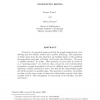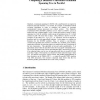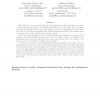115 search results - page 12 / 23 » Geometric graphs with no two parallel edges |
JCT
2007
13 years 7 months ago
2007
A brick is a 3-connected graph such that the graph obtained from it by deleting any two distinct vertices has a perfect matching. The importance of bricks stems from the fact that...
CIAC
2000
Springer
13 years 11 months ago
2000
Springer
A minimum spanning tree (MST) with a small diameter is required in numerous practical situations. It is needed, for example, in distributed mutual exclusion algorithms in order to ...
COMPGEOM
2006
ACM
14 years 1 months ago
2006
ACM
This paper addresses the problem of representing the connectivity information of geometric objects using as little memory as possible. As opposed to raw compression issues, the fo...
SPAA
2009
ACM
14 years 8 months ago
2009
ACM
We analyze the correctness and complexity of two well-known routing algorithms, introduced by Gafni and Bertsekas (1981): By reversing the directions of some edges, these algorith...
CW
2002
IEEE
14 years 10 days ago
2002
IEEE
Metamorphosis between 3D objects is often the transformation between a pair of shapes that have the same topology. This paper presents a new model using Reeb graphs and their cont...



